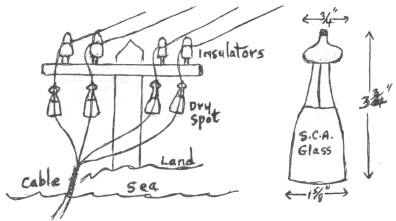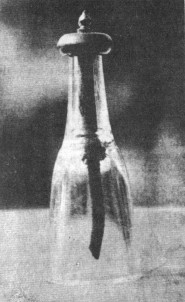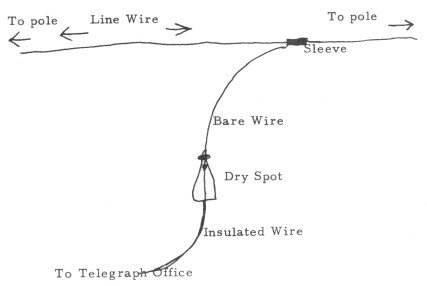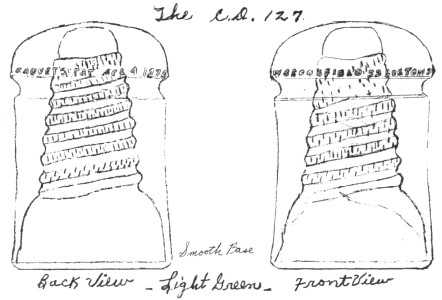Research Division
Reprinted from "INSULATORS - Crown Jewels of the Wire", October 1977, page 13
Dora,
I recently purchased the most interesting transposition and found not to
be in Miholland's Book. A CD 201 H.G. Co., and embossed on the back is
"PATENT May 2, 1883". This I have never seen before and was wondering
how odd this piece could be.
Thank you.
John de Sousa
East Granby, Connecticut
- - - - - - - - -
John:
This CD 201 is not common around here, but let's see what collectors in
other different areas have to say.
Dora
Dear Dora,
I read with much interest Doug Polak's letter in the August
issue. I, too, had noticed this particular kind of insulator, and thought that I
had stumbled upon a jewel, especially when I noticed Mr. Milholland's "open" price for it on Line 1419 in the 1976 price guide. However, when I
wrote Dee Willett about this, he replied that these "inner skirt drip
points" were caused by vents in the mold to permit gas to escape to prevent
bubbles, gas swirls, etc. Dee pointed out that all Brookfield insulators that
have an inner skirt have these points, and that Brookfield was the only maker to
use this method.
Dick Bales
Aurora, Illinois

Recently I obtained in trade two unusual insulators that were used as
transitions from cable to telegraph line, as shown in the diagram above. The
information I got was that they came from the San Juan Islands and were used
on an early telecommunication system. The metal cap attached to the top of the
insulator is either pewter or a galvanized metal of some kind. There is a small
hole through it for the wire to pass through to the line on land. The S.C.A.
glass is a three piece mold.
Has anyone found any of these, and can anyone tell me anything more about
this type?
Mel Allen
#153 1840 160 St.
Surrey, B.C., Canada U4A 4X4
- - - - - - - - - -
Editor's Note:
In the September 1970 Issue of Crown Jewels on pages 24 and 25 is a
letter from Gordon Smith, then of Wachula, Florida. He wrote, enclosing the
picture shown at the left and the diagram below:

"The enclosed picture depicts an interesting "jewel" we have.
"Will you ask your readers if anyone has them? The color is clear to
light amethyst.
"These were used by Postal Telegraph Co. and were known as "dry
Spots" because they created a dry spot at the end of the drop wire
insulation. The early drop wire was cloth covered and would deteriorate when
moisture got under it."

Dear Dora,
While at a flea market recently I picked up a CD 155. It was in a large
basket with other assorted CD 155's. The salesman told me he bought the whole
basket of insulators (about 25) at an auction 4 years ago. He said they were
hard to get rid of now, so he accepted my first offer on the insulator I wanted.
It is a CD 155 Armstrong in near clear glass. It is embossed:

(Note backward n and r on circle in Armstrong.) Now here comes the oddity. It
has the perfect embossing of a 1964 nickle on the crown top. It is embedded in
the top in such a way that a nickle will lay perfectly in it. When viewed from
the top, it is backward; but when looked at from the threaded inside, it is
correct. Could a nickle have fallen into the mold? (Accidentally? or on
purpose?) Hope I can find something out about this odd ball.
Bob Brophy
Philadelphia, Pennsylvania
Dear Dora & Don:
I'm working with and buying more CD 127, and I have found one more thing
about these Brookfield insulators.
This picture will show you the way I think this insulator was made and why I
think it was made this way.

In the pin hole groove there are small raised bars, the groove being the
indented part of the threads, and the ridge being the high part of the threads
in the pin hole.
Now the wood pin, being made the same way as the pin hole, when the insulator
is screwed on the pin, the groove of the insulator then fits perfectly on the
ridge of the pin. At this point these small raised bars are exactly on top of
the ridge of the wood pin.
After talking to some fellow collectors, we decided these small bars would
now prevent this insulator from turning on the pin. And it is our guess these
small bars were made in these insulators for this reason.
This is not a one of a kind, but it is odd. I have three of the green ones
and two of blue, one ice blue. They are all made of very heavy glass and all are
embossed just above the wire groove, side of crown:
F.) W Brookfield 55 Fulton St.
B.) Cauvets Pat Apl 4 1870 (or Apl 4 1871 - only one date to each insulator).
On an insulator buying trip I found and bought all of these insulators at the
same place, and I bought all that were there. This could turn out to be a pretty
good insulator.
A. L. Rash
Rt. 3, Box 669
Silsbee, TX 77656
after 7 p.m. 1-713-755-4185
| 